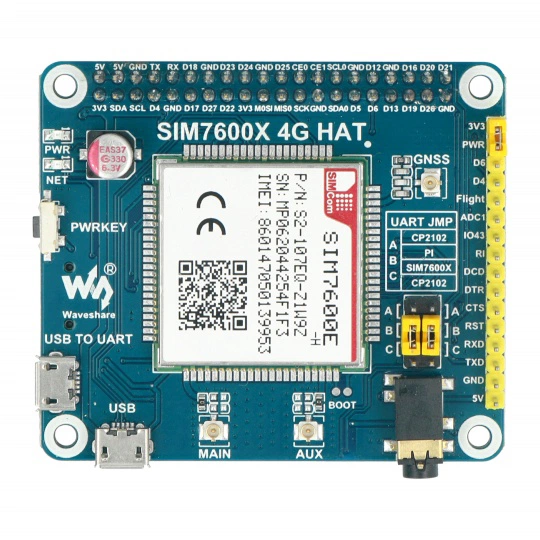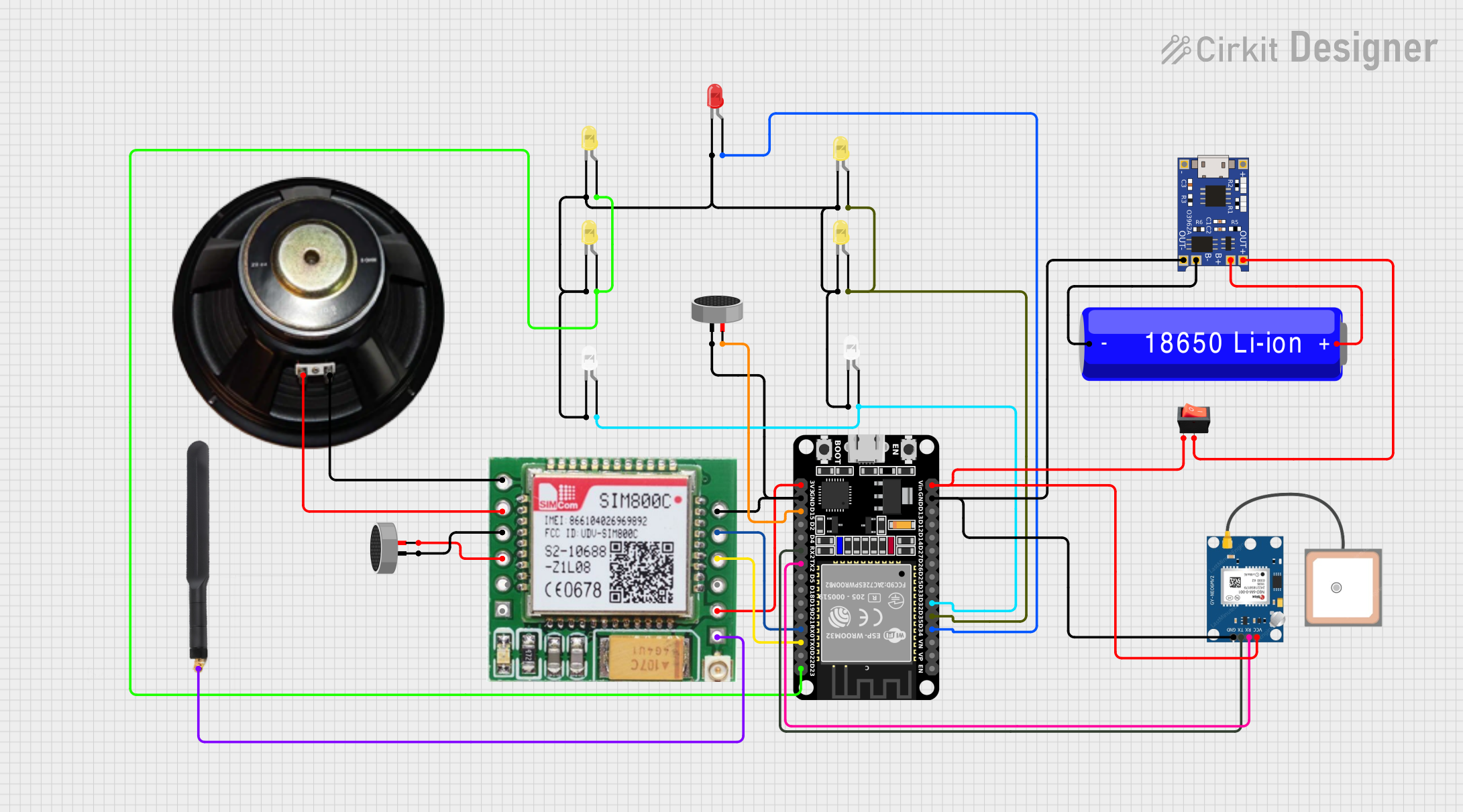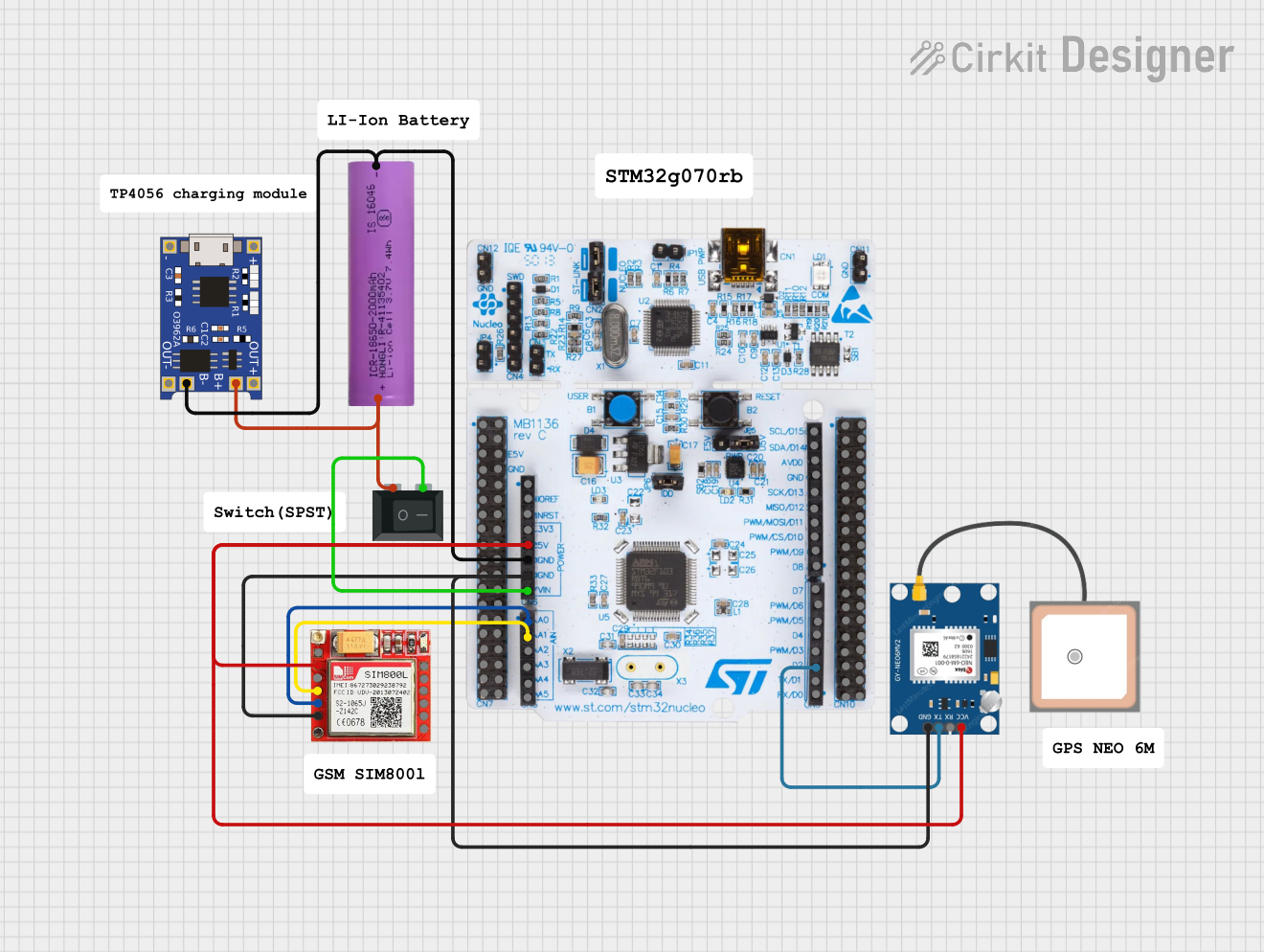
How to Use SIM7600E-H LTE GPS HAT : Examples, Pinouts, and Specs

 Design with SIM7600E-H LTE GPS HAT in Cirkit Designer
Design with SIM7600E-H LTE GPS HAT in Cirkit DesignerIntroduction
The SIM7600E-H LTE GPS HAT (Manufacturer Part ID: 14952) by Waveshare is a versatile module designed to provide LTE cellular connectivity and GPS functionality. This HAT is compatible with Raspberry Pi and other development boards, making it an excellent choice for IoT applications. It supports multiple communication protocols, including LTE, GSM, GPRS, and GNSS, enabling remote monitoring, tracking, and data transmission.
Explore Projects Built with SIM7600E-H LTE GPS HAT

 Open Project in Cirkit Designer
Open Project in Cirkit Designer
 Open Project in Cirkit Designer
Open Project in Cirkit Designer
 Open Project in Cirkit Designer
Open Project in Cirkit Designer
 Open Project in Cirkit Designer
Open Project in Cirkit DesignerExplore Projects Built with SIM7600E-H LTE GPS HAT

 Open Project in Cirkit Designer
Open Project in Cirkit Designer
 Open Project in Cirkit Designer
Open Project in Cirkit Designer
 Open Project in Cirkit Designer
Open Project in Cirkit Designer
 Open Project in Cirkit Designer
Open Project in Cirkit DesignerCommon Applications
- IoT-based remote monitoring systems
- GPS tracking for vehicles and assets
- Smart agriculture and environmental monitoring
- Industrial automation and telemetry
- Emergency communication systems
Technical Specifications
Key Technical Details
| Parameter | Specification |
|---|---|
| Cellular Module | SIM7600E-H (LTE CAT4) |
| LTE Bands | B1/B3/B5/B7/B8/B20/B38/B40/B41 |
| GNSS Support | GPS, GLONASS, BeiDou/Compass, Galileo, QZSS |
| Communication Interfaces | UART, USB, GPIO |
| Input Voltage | 5V (via Raspberry Pi GPIO) or 7-36V (via external DC jack) |
| Power Consumption | Idle: ~20mA @ 5V, Active: ~200mA @ 5V |
| Operating Temperature | -40°C to +85°C |
| Dimensions | 65mm x 56mm |
| Antennas | LTE antenna, GPS antenna (included) |
| SIM Card Slot | Micro SIM card slot |
| Compatibility | Raspberry Pi (all models with 40-pin GPIO), Arduino, and other microcontrollers |
Pin Configuration and Descriptions
The SIM7600E-H LTE GPS HAT connects to the Raspberry Pi via the 40-pin GPIO header. Below is the pin configuration:
| Pin Number | Pin Name | Description |
|---|---|---|
| 1 | 3.3V | Power supply for the HAT (3.3V) |
| 2 | 5V | Power supply for the HAT (5V) |
| 6 | GND | Ground |
| 8 | TXD | UART Transmit (to Raspberry Pi RXD) |
| 10 | RXD | UART Receive (to Raspberry Pi TXD) |
| 12 | PWRKEY | Power key to turn the module on/off |
| 16 | NETLIGHT | Network status indicator |
| 18 | STATUS | Module status indicator |
Usage Instructions
How to Use the Component in a Circuit
Hardware Setup:
- Attach the SIM7600E-H LTE GPS HAT to the Raspberry Pi's 40-pin GPIO header.
- Connect the included LTE and GPS antennas to the respective SMA connectors on the HAT.
- Insert a micro SIM card into the SIM card slot.
- Power the HAT using the Raspberry Pi's GPIO (5V) or an external DC power supply (7-36V).
Software Setup:
- Install the required drivers and libraries for the SIM7600E-H module. On Raspberry Pi, you can use the following commands:
sudo apt-get update sudo apt-get install ppp minicom - Configure the serial port by enabling UART on the Raspberry Pi. Use
raspi-configto enable the serial interface.
- Install the required drivers and libraries for the SIM7600E-H module. On Raspberry Pi, you can use the following commands:
Testing LTE Connectivity:
- Open a terminal and use
minicomto communicate with the module:sudo minicom -D /dev/ttyS0 - Send AT commands to test connectivity:
AT(Check communication)AT+CPIN?(Check SIM card status)AT+COPS?(Check network registration)
- Open a terminal and use
Using GPS Functionality:
- Send the following AT commands to enable GPS:
AT+CGPS=1,1 // Enable GPS AT+CGPSINFO // Get GPS location data
- Send the following AT commands to enable GPS:
Important Considerations and Best Practices
- Ensure the SIM card has an active data plan for LTE connectivity.
- Place the GPS antenna in an open area for better satellite reception.
- Use proper standoffs to secure the HAT to the Raspberry Pi.
- Avoid powering the HAT solely through the Raspberry Pi if additional peripherals are connected, as it may exceed the Pi's power capacity.
Example Code for Arduino UNO
The SIM7600E-H can also be used with an Arduino UNO via UART. Below is an example code snippet to send an AT command and read the response:
#include <SoftwareSerial.h>
// Define RX and TX pins for SoftwareSerial
SoftwareSerial sim7600(10, 11); // RX = 10, TX = 11
void setup() {
Serial.begin(9600); // Initialize Serial Monitor
sim7600.begin(9600); // Initialize SIM7600 UART communication
Serial.println("Initializing SIM7600...");
delay(1000);
// Send AT command to check communication
sim7600.println("AT");
delay(500);
// Read and print the response
while (sim7600.available()) {
Serial.write(sim7600.read());
}
}
void loop() {
// Add your main code here
}
Troubleshooting and FAQs
Common Issues and Solutions
Module Not Powering On:
- Ensure the HAT is properly connected to the Raspberry Pi GPIO header.
- Check the power supply voltage (5V via GPIO or 7-36V via DC jack).
No Network Connection:
- Verify that the SIM card is inserted correctly and has an active data plan.
- Check the antenna connections and ensure the LTE antenna is securely attached.
GPS Not Working:
- Place the GPS antenna in an open area with a clear view of the sky.
- Ensure GPS is enabled using the
AT+CGPS=1,1command.
No Response to AT Commands:
- Confirm the UART connection (TX and RX pins) is correct.
- Check the baud rate settings in your software (default: 9600).
FAQs
Q: Can I use this HAT with a microcontroller other than Raspberry Pi?
A: Yes, the SIM7600E-H LTE GPS HAT can be used with other microcontrollers like Arduino, provided you connect it via UART or USB.
Q: How do I update the firmware of the SIM7600E-H module?
A: Firmware updates can be performed via the USB interface using the manufacturer's tools. Refer to Waveshare's official documentation for detailed instructions.
Q: What is the maximum data rate supported by the LTE module?
A: The SIM7600E-H supports LTE CAT4 with a maximum download speed of 150 Mbps and upload speed of 50 Mbps.
Q: Can I use this module for voice calls?
A: Yes, the SIM7600E-H supports voice calls. You can use AT commands like ATD to dial a number.